Introduction
The development of art and architecture of the African countries have been significantly predetermined by historical events and environmental factors. Cameroon is a country in the Central Africa. Cameroon’s population is divided into three primary ethnic groups. Every group has peculiarities of art and architecture. Although there are differences in visual manifestations of works of art, the central aim of the art in Cameroon is to glorify the royal power of kings.
Overview of the African Art
The continent of Africa is known as the cradle for human beings. The majority of scientists agrees that human life commenced in Africa. Archeologists have found cultural artifacts that are more than 70 000 years old in Africa. This fact proves the statement that Africa is the source of humanity. After Asia, Africa is the next largest continent in the world. It is also the second most populated continent.
Nowadays, almost fifty various nations comprise Africa. The continent has an immense geographical and environmental diversity that influences the development of art. Nearly seven hundred million people live in the contemporary Africa. Besides, scholars estimate that there are more than one thousand different languages. There is no doubt that such diversity impacts the ways of expression of art in various tribes and cultures.
Most pieces of art of African nations have formal functions. The notion of purely aesthetic art was introduced after the colonization. Functional pieces of art were used for rituals. Sculptures represent the dominant type of art. The most widespread medium is wood. Masks also play a significant role in the African art. One more distinctive feature of the African pieces of art is that they depict the transformed or adorned bodies. Finally, numerous pieces of art serve as one element of something bigger. Thus, they can be used in the combination with dances, music, and prayers. The African architecture is largely influenced by the geographical patterns.
Cameroon Grasslands
Cameroon is a country in central and western parts of Africa that experiences a relative stability in comparison to other countries. The official name of the country is the Republic of Cameroon. The highest mountain of Africa is situated here — mountain Cameroon. Cameroon is often called “Africa in miniature” due to its vast geological diversity. There are mountains, beaches, deserts, savannas, and forests. The wildlife of the region has a great variety as well.
The western part of Cameroon is known as the Grasslands area. Three primary ethnic groups live in this area. There are almost 100 000 individuals who form the first ethnic group — Bamum people. Almost one million representatives belong to the second group — Bamileke. Bamenda-Tikar people are the third ethnic group with the overall population of half a million.
People of Cameroon practice various religions. Thus, the majority of residents from the Northern part of the country are Muslims. There are also numerous followers of Christianity. Although Christianity is widespread here, polygamy is usually practiced. Thus, families are large. The role of men is to bring meat to home and work in the field while women should be housekeepers. The native religion is animism. It is deeply rooted in the African art. Some people still believe in animism. Beliefs in witchcraft are also widespread. Although government prohibits such activities, it is a significant part of the social life. Woman who is suspected of being a witch may suffer from a terrible public violence.
The dominance of male gender is a distinctive feature of the Cameroon society. A cruel and discriminative treatment of women is a usual thing in Cameroon Grasslands. Besides, the society is well known for the ruthless tradition of ironing of women’s breasts. Almost thirty percent of girls who experience the initial stages of the sexual maturation undergo that terrible procedure. The aim of the ritual is to prevent the development of breasts and, in such a way, protect girls from sexual violence. The other brutal practice is a mutilation of female genitals.
Leadership as a Central Element of Art
Kings and other royal representatives always played a crucial role in the development of art. The word “fon” is used to describe leaders of numerous kingdoms in Cameroon Grasslands. The ruler was the protector of people. He was responsible for the well-being of people, and his power was glorified through art. As Fraser and Cole write, “As a man of wealth and influence, the ruler is also the major patron of the arts; he is usually by elaborate, often monumental, sculptures and architectural reliefs which silently but eloquently proclaim his economic, socio-political, and religious ascendancy.” Thus, leaders invited artists to their palaces and gave them space and all necessary materials for their work.
Only best artists were chosen to create pieces of art for the ruler and his court. It should be noted, that that styles of dissimilar kingdoms are interconnected. It happened because of the developed trade and the tradition of bringing gifts. Artists used various materials for their works, but wood was the most popular. Sculptures were the most widespread pieces of arts.
Besides, artists made stools, thrones, drinking attributes, masks, hairdressers, necklaces, swords, bowls, horns, and pipes. One more distinctive feature of the design was the depiction of animals, especially those that symbolized royalty. Rams, buffalos, and leopards were symbols of strength and mighty and, usually, glorified the king. The depicted mask was used as the gift of trust by kings (Fig. 1).

Court Art and Architecture of Ethnic Groups
Bamum People
The flourishing of royal art and architecture continued until the period of colonization. The last brilliant leader of Bamum people was King Njoya. He was a visionary ruler, who executed his royal functions of the sovereign with exclusive mastery. Unfortunately, the French sent him into exile. Nevertheless, he contributed significantly to the development of art. King Njoya was open to the foreign influence. Thus, he built his palace under the influence of Western and Islamic styles of architecture. In 1912, a three-story palace was ready, and it was a work of art that combined European and traditional styles. King Njoya is depicted in front of his palace in the photo (Fig. 2).
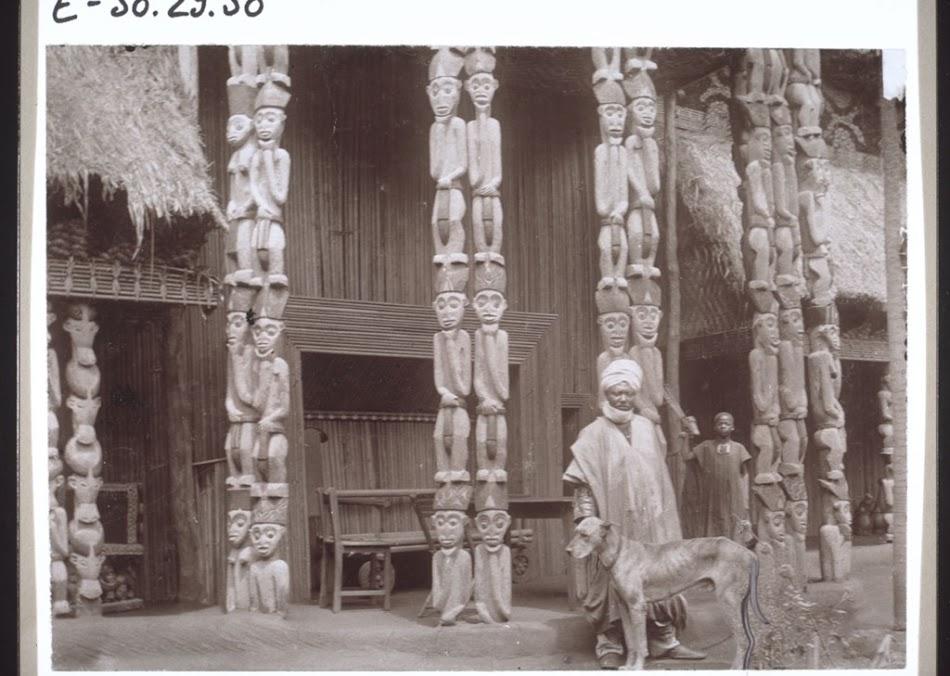
The celebration of king’s power is often presented through the creation of decorative thrones. Thrones are usually made of wood. Different animals and people are carved on them. The artist had to choose the pictures carefully as far as they should represent the particular features of king’s reign. Thus, it could be wisdom, strength, or wealth. In most cases, leopards and elephants were depicted on thrones because they were the principal symbols of the dynastic and royal power.
Besides, sculptures of thrones were regarded as very significant gifts. Also, thrones might be decorated with beads and shells. The Royal Throne and Footstool of Nsangu, King of Bamum, is a vivid example of the unique mastery that glorifies the late King (Fig. 3).
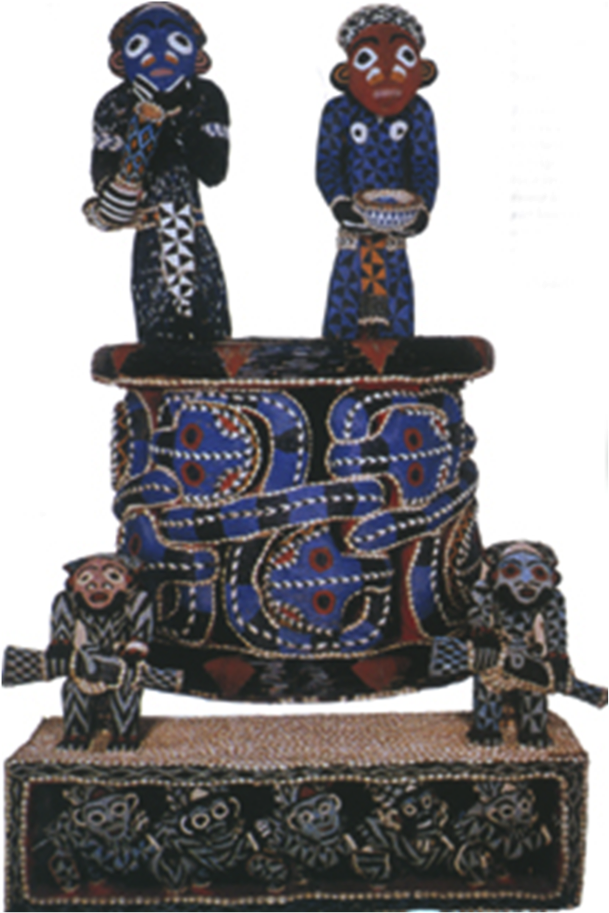
Although wood was the most widespread material, archeologists found numerous sculptures made of the different medium. In most cases, it is almost impossible to recognize whether the sculpture depicts some leader, royal individual or a simple servant. However, the sculpture of Anthropomorphic Pommel (Fig. 4) on Prestige Sword has distinctive features of royalty.

The figure serves as a decoration for the Prestige Sword — a weapon that is used at ceremonies. The posture of the figure is typical of kings. Despite small breasts, bracelets and hairstyle demonstrate that it is a leader or fon. However, the most distinctive feature is the image of the snake. Together with leopard and buffalo, snake was the royal animal as well. The snake is more likely to be python as far as this animal is regarded as noble.
Bamileke People
Bamileke people comprise the second large ethnic group of Cameroon. They can be found almost in all places of the country as far as they live in small groups. Nowadays, many Bamileke people are followers of Islam. However, in the past there were numerous kingdoms. Ritual life of Bamileke people was directly connected with their artworks. For instance, Bamileke always considered death as something mysterious and unknown. A variety of artifacts was used during these rituals. The ritual statue (Fig. 4) was used during the ceremonies. Its aim was to increase fertility.
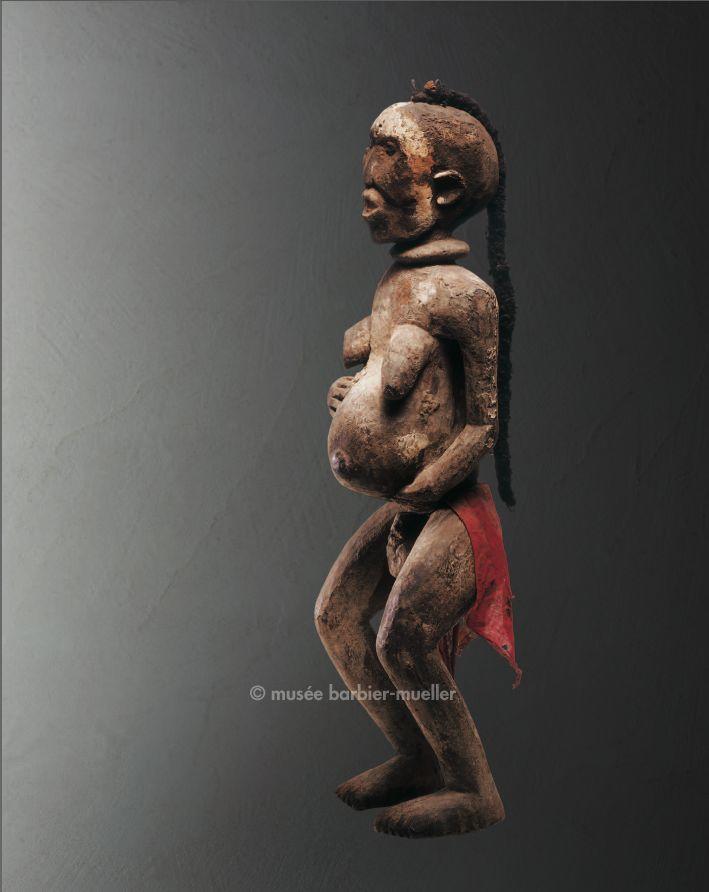
Zoomorphic masks were typical among Bamileke kingdoms. Masks depicted animals that symbolized power and strength of the king. Two zoomorphic masks were the most widespread: elephant mask and “helmet” mask with carved buffalo. Every mask had a particular role. Thus, elephant mask should be worn on the special occasion when king met representatives of military forces. Buffalo mask demonstrated the supreme power of the king and his glory. Only the ruler had the right to wear buffalo mask. Here is the example of the buffalo helmet mask (Fig. 5)
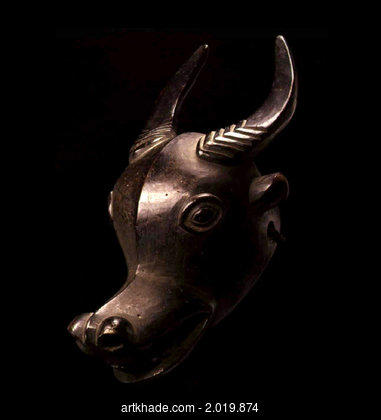
The court architecture of Bamileke people is also worthwhile attention. Thus, palaces were places of the residence of kings. Consequently, rulers aimed at differentiating their palaces with the help of creative architecture. Doorframes are of particular significance for palaces. Artists used the images of human bodies as a decoration of frames. Such doorframes left a remarkable impression on everyone who entered the palace. The buildings were large and resembled military establishments. The following photo is the example of the Bamileke doorframe (Fig. 7).
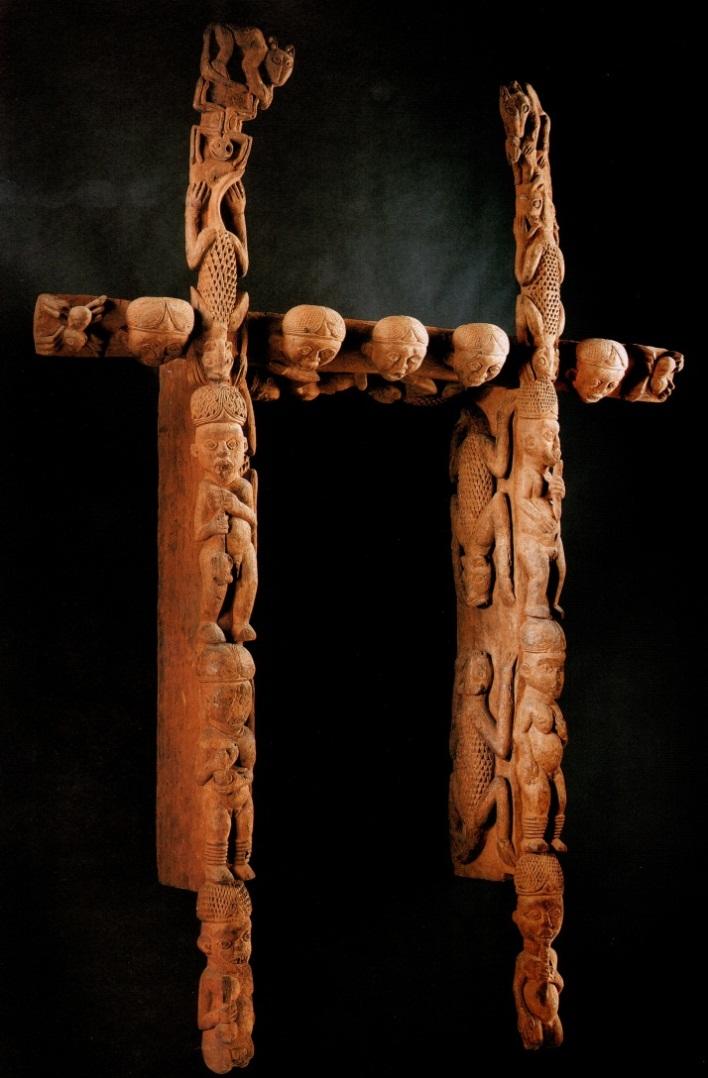
Other Ethnic Groups
Tikar people form another large ethnic group in Cameroon. They are also called Tikari, Tingkala, or Bamenda-Tikar. As in other cultures, the objects of arts were mainly created for the leader. They also could be used in various rituals. Sometimes, archeologists and scholars face difficulty in proper identification of sculptures due to the mix of styles. Most pieces of arts symbolized the particular position in the royal palace19. The Pipe in the form of Human Figure (Fig. 8) represents the mastery of art at kingdoms of Tikar people.

The coastal region of Cameroon has its peculiarities as well. People who live along the coast are called Duala people. Their way of life was different from that of other groups as far as it was influenced by their geographical location. Besides, Duala people were the first who came into contact with Europeans. Their social and economic status was better than in other regions because of the trade.
The royal art of Duala people was manifested mainly via stools and zoomorphic masks. One can observe the influence of the European civilization on these works of art. The most vivid feature was that they used bright paints. The received paints from foreigners. It made Duala’s art vivid. The Bovid Mask (Fig. 9) is the representation of the colorful style of Duala’s art.
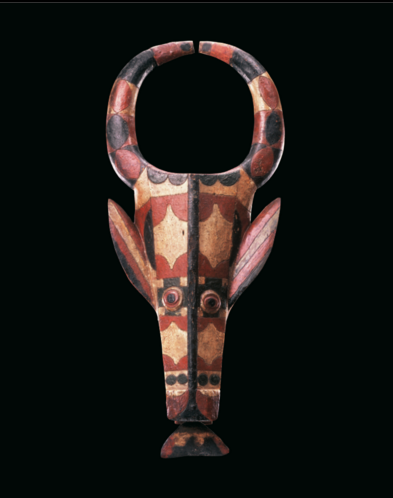
Conclusion
The development of art and architecture of people from Cameroon Grasslands was significantly predetermined by historical reasons. Thus, kings were the patrons of arts, and they supported the creation of works of art. There are three primary ethnics groups in Cameroon Grasslands — Bamum, Bamileke, and Tikar people. Duala people comprise the separate group from the coastal region.
Although there were differences in the ways of life, the primary aim of art in all groups was to glorify the power of the ruler. Most sculptures were made of wood. Artists created such objects of art as drinking horns, smoking pipes, necklaces, human bodies, and stools. The distinctive features of the royal works of art were carved images of leopard, elephant, snake, or buffalo. These animals were considered as royal, and their depiction was allowed only for kings and leaders.
Bibliography
Anthropomorphic Pommel. 19th century. Brass, iron blade. Geneva, Musée Barbier Mueller, inv. 1018-129. Web.
Bovid Mask. 19th century. Polychromed wood. Geneva, Musée Barbier-Mueller, inv. 1018-2. Web.
Clarke, Christa. The Art of Africa. New York: The Metropolitan Museum of Art, 2006. Web.
Dickerson, Madelynn. The Handy Art History Answer Book. Canton: Visible Ink Press, 2013. Web.
Doorframe. 19th century. Wood. Staatliches Museum für Völkerkunde, Berlin, inv. III c 21052 a-c. Web.
Fraser, Douglas, and Herbert Cole. African Art and Leadership. Madison: University of Wisconsin Press, 2004. Web.
Helmet Mask. 19th century. Wood. Paris, Artkhade Auctions Database, inv. 2.019.874. Web.
Intersections: World Arts, Local Lives. Los Angeles: Fowler Museum at UCLA, 2006. Web.
Koloss, Hans-Joachim. Africa: Art and Culture. Munich: Prestel, 2002. Web.
Lifshitz, Fima. An African Journey Through its Art. Bloomington: AuthorHouse, 2009. Web.
Mandu Yenu (Royal Throne) and Footstool of Nsangu, King of Bamum. 1870. Wood textile, glass beads, cowrie shells. Berlin, Staatliches Museum für Völkerkunde, inv. III C 33341 a-b. Web.
Mask. Late 19th century. Wood, paint, iron, dowel, plant fiber, plant gum. Los Angeles, Fowler Museum at UCLA, inv. 65.820. Web.
Mlbabu, John. Culture and Customs of Cameroon. Westport: Greenwood Publishing Group, 2005. Web.
Ngwainmbi, Emmanuel. “Bamileke.” In Encyclopedia of African Religion, edited by Molefi Asante and Ama Mazama, 133. Thousand Oaks: Sage Publications, Inc., 2009. Web.
Pipe in the form of Human Body. 20th century. Ceramic. Minneapolis, The Christina N. and Swan J. Turnblad Memorial Fund, inv. 95.7.1. Web.
Ritual Statute. 19th century. Wood, pigments, fabric, human hair. Geneva, Musée Barbier-Mueller, inv. 1018-78. Web.
Shwarz, Eugen. “King Njoya in front of the Reception-Hall in Fumban.” BMArchives. 2015. Web.